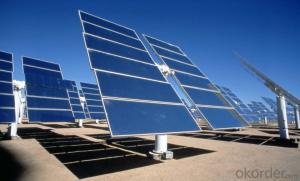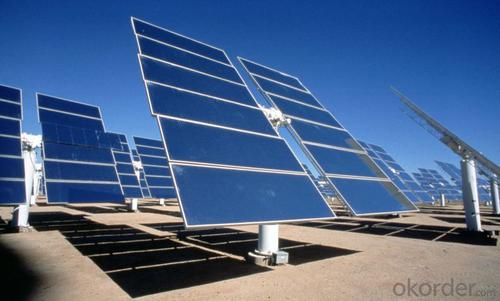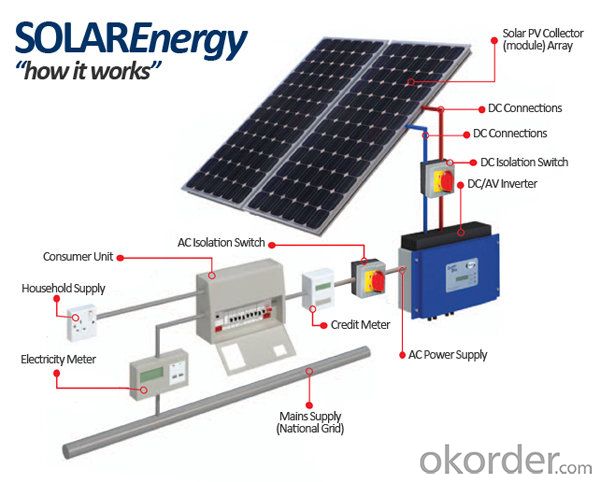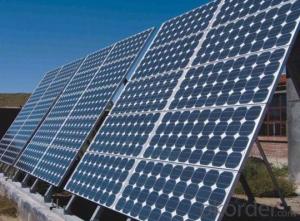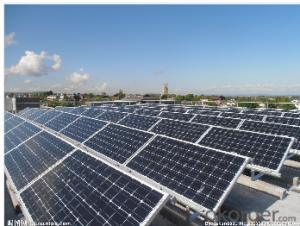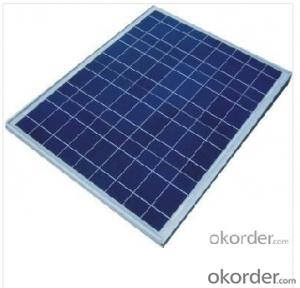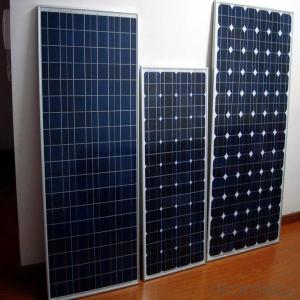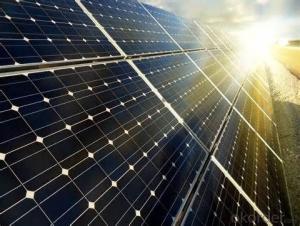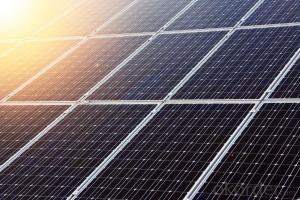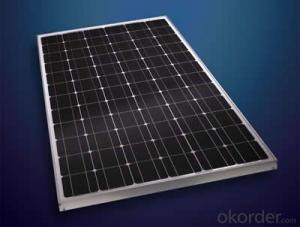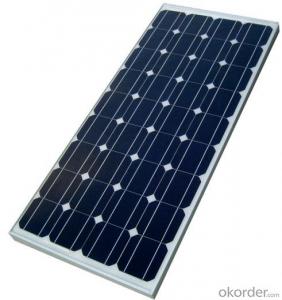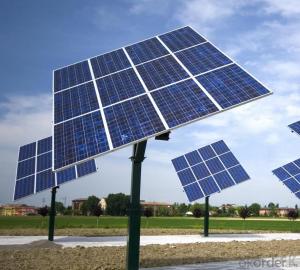Lunar Solar Panels - 290w Poly Solar Module with High Efficiency
- Loading Port:
- Tianjin
- Payment Terms:
- TT OR LC
- Min Order Qty:
- 1 watt
- Supply Capability:
- 100000 watt/month
OKorder Service Pledge
OKorder Financial Service
You Might Also Like
Specification
Product Description:
1.Structure of Solar Module Description
CNBM Solar's photovoltaic module is designed for designed for large electrical power requirement. It is the optimal choice for both on-grid and off-grid power systems. CNBM Solar offers high performance of power per square foot of solar array.
2.Main Features of the Solar Module
Solar Cell: High efficency crystalline solar cell. Even if under the weak light, the solar module can produce maximum power output.
Tempered glass: Anti-reflecting coating and high transmission rate glass increase the power output and mechanical strength of solar module.
EVA and TPT: Using high quality EVA and TPT to prevent destroying and water.
Strong aluminum frames to strengthen the load hold and to stand against high wind.
Junction box: Multi function junction box with water proof.
Long lifetime: ≥25 years; Less power decrease.
Good performance of preventing from atrocious weather such as wind and hails.
Resisting moisture and etching effectively, not effected by geology.
The certificate issued by international authority: UL, TUV, IEC, VDE, CE.
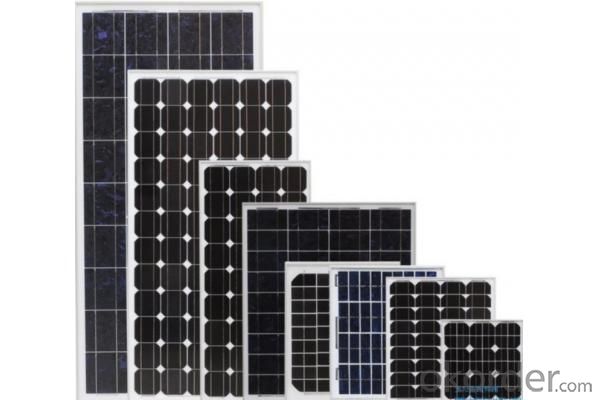
Solar panel working process
In addition to being the ultimate source of all life on earth, the sun is an infinitely renewable, completely pollution-free source of electricity. Instead of burning fossil fuels dug up from the ground in a big power plant – a very 19th century, industrial age approach, when you think about it – solar panels convert sunlight directly into electricity, with no harmful emissions.
The basic unit of a solar panel is a solar cell, which usually consists of one or two layers of silicon-based semiconductor wafers. When struck by the photons in sunlight, the solar cell generates an electrical charge due to the "photovoltaic effect" – which is a pretty good name, since it produces voltage from photons. The flow of these electrons moves in a steady electrical current from one side of the cell to the other.
Dozens of these PV cells are packaged together into solar modules, which in turn are packaged into solar panels that are mounted on a rooftop and arranged to maximize their hours of exposure to direct sunlight. Because the electricity generated by all those solar cells is direct current (DC), it is then sent to an inverter that transforms the power into the same alternating current (AC) used by the appliances in your home and the local utility electricity distribution grid. Increasingly, these inverters are getting "smart," providing data monitoring for solar installation performance and other grid integration services.
- Q: How do solar panels perform in extreme temperatures?
- Solar panels can still generate electricity in extreme temperatures, but their efficiency may be slightly affected. In high temperatures, solar panels may experience a decrease in their power output due to increased resistance in the electrical circuits. In extremely cold temperatures, solar panels may become less efficient temporarily, but they can still produce electricity as long as there is sunlight. Overall, while extreme temperatures can have a minor impact on solar panel performance, they are designed to withstand a wide range of weather conditions and continue to produce clean energy.
- Q: So during the day, electricity is on, everything is on and working fine. But at night where there is no sunlight does all the electricity shut down for the night? So there is no light on for me during the night, or I can't watch tv at night? Is it also true that with solar panels, your bills are less expensive. Can someone please tell me these things
- But at night where there is no sunlight does all the electricity shut down for the night? Electrical production shuts down, but most solar electric systems have some way of storing power. There are two main types of storage: . Grid tie. Basically this uses the power grid as a virtual battery. You produce extra power during sunlight hours to sell to the grid (other people use it) and you buy power from the grid when the sun doesn't shine. This is usually the most economical system, but whether you save money depends on a lot of things like: cost of installation, location, government subsidies how much you get for the electricity you sell buy. In other words, the details matter. Mostly location, which determines how much sunlight you get, electric rates, and subsidies. 2. Batteries. Usually a large bank of deep cycle lead acid batteries. Usually only used in off-grid systems and the cost of electricity is usually not competitive with grid electricity.
- Q: Are there any limitations to the lifespan of solar panels?
- Yes, there are limitations to the lifespan of solar panels. While solar panels are designed to be durable and long-lasting, they do have a finite lifespan. The average lifespan of solar panels is typically around 25-30 years. However, environmental factors, such as extreme weather conditions, can affect their performance and longevity. Over time, solar panels may experience degradation, reducing their efficiency and power output. Additionally, technological advancements may render older solar panel models outdated or less efficient. Despite these limitations, proper maintenance and regular cleaning can help extend the lifespan of solar panels.
- Q: I need to find a way to clean solar panels that automated, at best;A way beside using a large 'squeegee'
- Hire Tinkerbell, Disney hasn't had much for her to do lately.
- Q: Can solar panels be installed on agricultural irrigation systems?
- Yes, solar panels can be installed on agricultural irrigation systems. They can provide a sustainable and efficient source of energy to power the irrigation system, reducing reliance on traditional electricity sources and reducing operational costs for farmers. Additionally, solar panels can help farmers become more environmentally friendly by reducing carbon emissions associated with irrigation.
- Q: Can solar panels be installed on forests or protected areas?
- Yes, solar panels can be installed on forests or protected areas, but it requires careful planning and consideration to minimize the impact on the environment and wildlife. The installation should be done in a way that avoids clearing large areas of trees and minimizes disturbance to the local ecosystem. By adopting best practices and consulting with experts, solar panels can be installed on forests or protected areas in a sustainable and responsible manner.
- Q: Are there any government incentives or rebates for installing solar panels?
- Yes, there are several government incentives and rebates available for installing solar panels. These incentives vary by country and even state in some cases. Examples include the federal solar Investment Tax Credit (ITC) in the United States, feed-in tariffs in certain European countries, and grants or rebates offered by local governments. It is advisable to check with local authorities or consult a solar installer to determine the specific incentives available in your area.
- Q: Can solar panels be installed in areas with high winds?
- Yes, solar panels can be installed in areas with high winds. However, it is crucial to consider the design, installation, and maintenance of the solar panel system to ensure its durability and stability in such conditions. Reinforcements and proper anchoring techniques can be employed to withstand the wind load and prevent any damage to the panels.
- Q: I need to know how do solar panels work. I need to know what are they made of.
- The term solar panel is best applied to a flat solar thermal collector, such as a solar hot water or air panel used to heat water, air, or otherwise collect solar thermal energy. But 'solar panel' may also refer to a photovoltaic module which is an assembly of solar cells used to generate electricity. In all cases, the panels are typically flat, and are available in various heights and widths.
- Q: Heard you can put solar panels on laptops Anyone know if it can work on a Dell mini 0v? I've seen he USB slot solar pana but can someone tell me where to gt these?
- That strikes me as completely impractical for most circumstances. The power output of your mains adapter is 30W and to do that you are looking at at least five or six square feet of solar panels costing in the region of $600 even from a surplus supplier I know. You could do it cheaper (maybe $50 on panels) but then you would be looking a more primitive panels and need perhaps thirty square feet of solar panels. This is a completely different exercise to creating a solar powered USB charger - the power requirement is a lot higher. Astronomy and space?
Send your message to us
Lunar Solar Panels - 290w Poly Solar Module with High Efficiency
- Loading Port:
- Tianjin
- Payment Terms:
- TT OR LC
- Min Order Qty:
- 1 watt
- Supply Capability:
- 100000 watt/month
OKorder Service Pledge
OKorder Financial Service
Similar products
Hot products
Hot Searches
Related keywords
